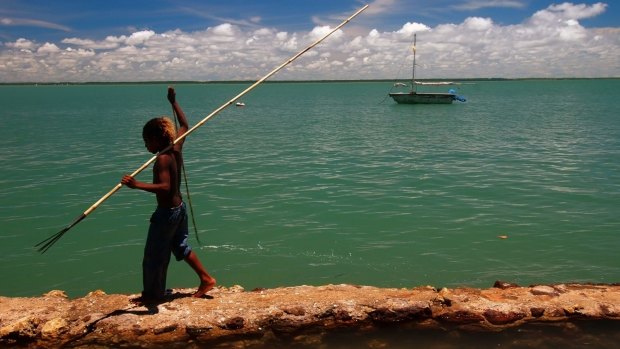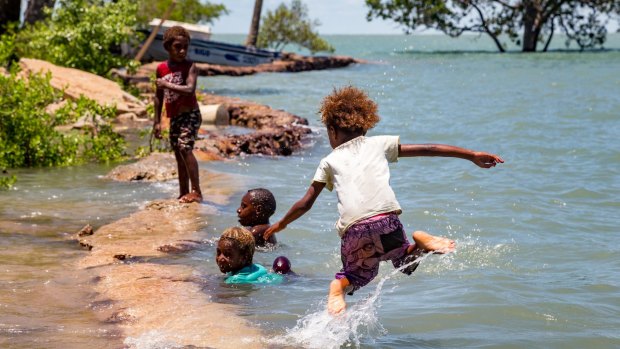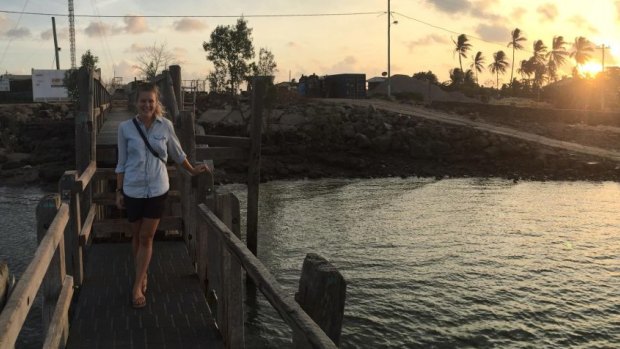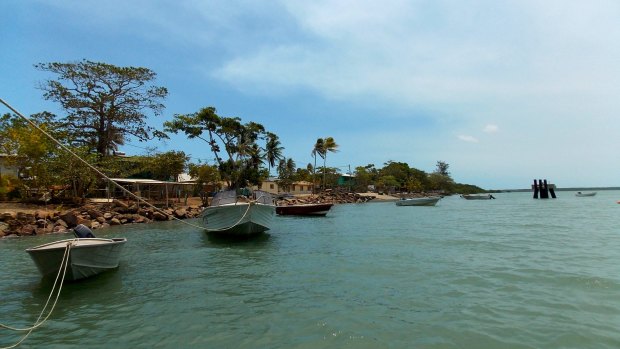This was published 6 years ago
The Torres Straits, Australia: An unlikely destination that provides a cultural experience like no other
By Jacqui Dunlop

A boy with fish spear walks along ineffective seawall, Saibai Island, Torres Strait.Credit: Alamy
Being welcomed to share in one of the oldest and richest cultures in the world was life-changing for our winner, Jacqueline Dunlop.
Thump, taka-taka, thump, takataka, thump. The beat is palpable, the kind of instinctual beat you hear in your veins. The drum's hourglass figure is inscribed with carvings; the instrument's owner is flawless as he increases the pace of the beat. The dancers in turn punch their feet hard on the ground in time with the shell-shakers that clap in their hands, choreography and instruments passed down generation to generation.
I am on Saibai, the northernmost island of the Torres Straits. This evening's activity is dance practice and I have been invited to watch. The dancers are practising for an upcoming tombstone opening, a joyful ceremony performed years after a funeral to release the spirit of the deceased. I am consciously aware that my invitation has been received largely due to my travelling companion, Aunty Ellie Laifoo, who has been coming to Saibai for the last 20 years.

Jacqueline (Jacqui) Dunlop, winner of the Traveller Young Travel Writers Competition 2017.
Tonight's performance is a precious and culturally sacred time in community, one not often shared with visitors. The beat goes on and rows of dancers ranging in age from four to 60 effortlessly turn, jump and duck in a symphony of unification. As they dance, the beat increases speed and the dust begins to stir, leaving the spectators with uniform shadows in the cloud.
Dancing and music are integral to a Torres Strait Islanders' life. Culture in the Torres Straits is strong and honest, heavily influenced by both Melanesian and Papuan traditions; it's the kind of culture that hits you straight between the eyes and cannot be unnoticed.
Few are fortunate enough to see this unique pocket of Australia, with the Torres Strait Islands so often categorised with mainland Aboriginal culture and peoples.So rarely are the islands understood as a unique standalone. My presence at dance practice draws curiosity from the community. I am not from this land, that is clear enough. However, this does not lead to exclusion. Rather, I am welcomed warmly, receiving smiles from children and young mothers coming to sit nearby to hear my story of where I am from and what has brought me to the far reach of Saibai Island.

Children on Saibai island swim in the tides.Credit: Alamy
It is wild country up here, only accessible by single or dual-propeller airplane. The Torres Straits are far closer to Papua New Guinea than to Australia, being only four kilometres south of PNG. Due to this proximity, PNG locals frequent the northern islands of the Torres Straits often for family and cultural reasons. The Torres Strait Treaty safeguards these ways of life and livelihoods of the traditional inhabitants of both the Torres Straits and PNG. This ensures that traditional community interactions may continue as they have done for the last 50,000 years, without the modern-day challenges of immigration and passports.
As dance practice continues, the nearby sound of the ocean redirects my attention to acknowledge the unbelievable splendour of this part of the world. Despite the beauty, it does not often receive visitors from down south. Of the 118 Torres Strait islands, only 18 are inhabited. Each island is unique in personality, both geographically and traditionally.
The Central Cluster (Yam,Warraber and Poruma) are coral cays that are so small that landing a single-engine six-seater aircraft proves difficult; the runway literally runs from one side of the island to the other, with only just enough room for the tiny plane to land and stop. The Eastern Cluster, which includes Mer/Murray Island, are volcanic islands, giants rising from the sea.

Sunset on Saibai, The Torres Straits, Australia.Credit: Jacqui Dunlop
From above, you can see the intertidal stonewalled fish traps, the verification used by Eddie Mabo to demonstrate to the High Court the ongoing connection and generational use of land in Mer.
At the end of the evening, Aunty Ellie asks me if I enjoyed dance practice. I nod, but its true impact has only come about since that night. To this day, I am continually reflecting on how fortunate I am to have had a front seat to one of the richest and oldest continuing cultures in the world.
Jacqueline (Jacqui) Dunlop, is an adviser for a non-for-profit in Canberra. She is a keen backpacker, trail-runner, wine-drinker and scuba diver. Her appetite for globetrotting has seen her hike Everest base camp, study gender relations in Sweden, surf badly in Sri Lanka, and work as horse-riding instructor in the Canadian Rockies.

Wil country: The Torres Straits.Credit: Jacqui Dunlop
Instagram: @jacdunlop
Sign up for the Traveller Deals newsletter
Get exclusive travel deals delivered straight to your inbox. Sign up now.